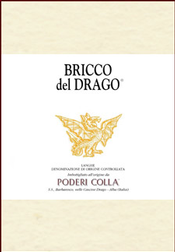Poderi Colla, Langhe (Piedmont, Italy) Bricco del Drago 2010 (Montcalm Wine Importers, Ltd., $32): I tasted this wine blind, and when the big reveal came, I knew at once that I needed to write about it, because the wine embodies so many stories. There’s the story of the Colla family, and the story of the Langhe appellation, as well as the story of the curious grape blend in this wine.
Tino Colla and his niece Federica created Poderi Colla barely more than 20 years ago, in 1993. But the family is no Johnny-come-lately to Piedmont wines, having been involved in grape growing and winemaking since the early 18th century. Beppe Colla — Tino’s older brother, Federica’s father, and winemaker at Poderi Colla — is one of the most  highly respected authorities on the wines of Piedmont’s Langhe hills, and the former winemaker of the Prunotto winery, now owned by Antinori. Poderi Colla encompasses three wine estates: One in Barolo, one in Barbaresco, and one within the borders of Alba, the town between those two wine zones.
highly respected authorities on the wines of Piedmont’s Langhe hills, and the former winemaker of the Prunotto winery, now owned by Antinori. Poderi Colla encompasses three wine estates: One in Barolo, one in Barbaresco, and one within the borders of Alba, the town between those two wine zones.
The Langhe Hills is a general name for the entire area around Alba, encompassing the DOCG zone of Barolo and Barbaresco and so many others. In the world of DOC appellations, Langhe DOC applies to a wide range of wines from that territory; many of these wines are from international grape varieties such as Chardonnay and Cabernet that cannot be part of older DOC/G wines, while others are from local varieties being brought back to the spotlight, such as Freisa and Favorita. Although Langhe became a DOC territory in 1994, some producers had been using the name more than a decade earlier for their wines from international varieties.
Not all Langhe wines are varietally labeled, and this point brings us to Poderi Colla’s Bricco del Drago. The wine is about 85 percent Dolcetto and 15 percent Nebbiolo, from a vineyard called Bricco del Drago (hilltop of the dragon). This is an unusual blend, but not new: The first Bricco del Drago vintage was 1969, under the estate’s previous ownership.
Dolcetto — with a few significant exceptions — is one of Piedmont’s everyday wines, a straightforward red with dark fruit flavors, spicy energy, some gritty tannin and a down-to-earth personality. The Nebbiolo grape, on the other hand, makes Piedmont’s most transcendent wines, Barolo and Barbaresco. Apples and oranges. But in Bricco del Drago, the blend does succeed.
The 2010 Bricco del Drago has a purplish hue of Dolcetto rather than the ruby color of young Nebbiolo. Its aroma is a bit more intense than is typical of Dolcetto, with typical notes of dark plum, dark berries, chocolate and black pepper spice, but also a delicate floral note and a suggestion of red fruits (Nebbiolo). In your mouth, the wine is dry and full-bodied, with higher acidity than Dolcetto would otherwise have, and polished tannins that seem less coarse than I would expect from Dolcetto. The red fruit of Nebbiolo carries Dolcetto’s earthy-and-spice base flavors into a higher dimension and brings a juicy character to the wine’s taste. The wine’s texture is smooth — a descriptor that I suspect I have never before used for a Dolcetto wine. In terms of quality markers, this wine has depth, concentration of flavor, full length across the palate and a long finish.
Dolcetto and Nebbiolo are such different grapes that—logically enough–they were fermented separately, at a cooler temperature and 5 to 8 days of skin contact for the Dolcetto and a warmer temperature for 10 to 12 days for the Nebbiolo. After blending, the wine spent one to two years in barrels of Slavonian oak, which to some extent accounts for the smoothness and polished tannins of the wine.
The 2010 Bricco del Drago is quite youthful now, and I found it improving over the two days that I had the bottle open. Personally, I enjoy it like this and suggest drinking it over the next five years.
91 Points
